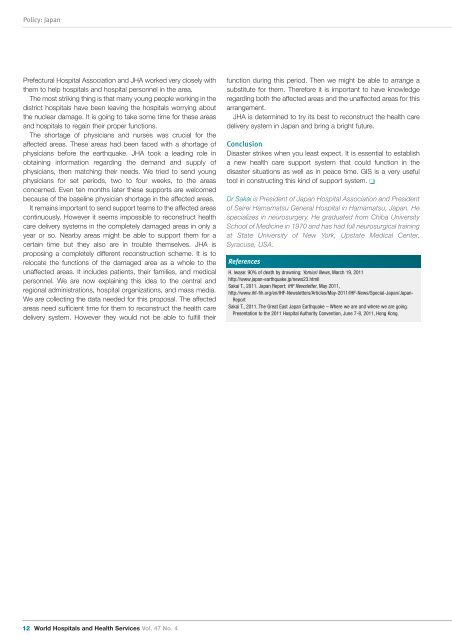web_vol47 4.pdf - International Hospital Federation
web_vol47 4.pdf - International Hospital Federation
web_vol47 4.pdf - International Hospital Federation
Create successful ePaper yourself
Turn your PDF publications into a flip-book with our unique Google optimized e-Paper software.
Policy: Japan<br />
Prefectural <strong>Hospital</strong> Association and JHA worked very closely with<br />
them to help hospitals and hospital personnel in the area.<br />
The most striking thing is that many young people working in the<br />
district hospitals have been leaving the hospitals worrying about<br />
the nuclear damage. It is going to take some time for these areas<br />
and hospitals to regain their proper functions.<br />
The shortage of physicians and nurses was crucial for the<br />
affected areas. These areas had been faced with a shortage of<br />
physicians before the earthquake. JHA took a leading role in<br />
obtaining information regarding the demand and supply of<br />
physicians, then matching their needs. We tried to send young<br />
physicians for set periods, two to four weeks, to the areas<br />
concerned. Even ten months later these supports are welcomed<br />
because of the baseline physician shortage in the affected areas.<br />
It remains important to send support teams to the affected areas<br />
continuously. However it seems impossible to reconstruct health<br />
care delivery systems in the completely damaged areas in only a<br />
year or so. Nearby areas might be able to support them for a<br />
certain time but they also are in trouble themselves. JHA is<br />
proposing a completely different reconstruction scheme. It is to<br />
relocate the functions of the damaged area as a whole to the<br />
unaffected areas. It includes patients, their families, and medical<br />
personnel. We are now explaining this idea to the central and<br />
regional administrations, hospital organizations, and mass media.<br />
We are collecting the data needed for this proposal. The affected<br />
areas need sufficient time for them to reconstruct the health care<br />
delivery system. However they would not be able to fulfill their<br />
function during this period. Then we might be able to arrange a<br />
substitute for them. Therefore it is important to have knowledge<br />
regarding both the affected areas and the unaffected areas for this<br />
arrangement.<br />
JHA is determined to try its best to reconstruct the health care<br />
delivery system in Japan and bring a bright future.<br />
Conclusion<br />
Disaster strikes when you least expect. It is essential to establish<br />
a new health care support system that could function in the<br />
disaster situations as well as in peace time. GIS is a very useful<br />
tool in constructing this kind of support system. ❏<br />
Dr Sakai is President of Japan <strong>Hospital</strong> Association and President<br />
of Seirei Hamamatsu General <strong>Hospital</strong> in Hamamatsu, Japan. He<br />
specializes in neurosurgery. He graduated from Chiba University<br />
School of Medicine in 1970 and has had full neurosurgical training<br />
at State University of New York, Upstate Medical Center,<br />
Syracuse, USA.<br />
References<br />
H. Iwase: 90% of death by drowning; Yomiuri News, March 19, 2011<br />
http://www.japan-earthquake.jp/news23.htmll<br />
Sakai T., 2011. Japan Report; IHF Newsletter, May 2011,<br />
http://www.ihf-fih.org/en/IHF-Newsletters/Articles/May-2011/IHF-News/Special-Japan/Japan-<br />
Report<br />
Sakai T., 2011. The Great East Japan Earthquake – Where we are and where we are going.<br />
Presentation to the 2011 <strong>Hospital</strong> Authority Convention, June 7-8, 2011, Hong Kong.<br />
12 World <strong>Hospital</strong>s and Health Services Vol. 47 No. 4
















